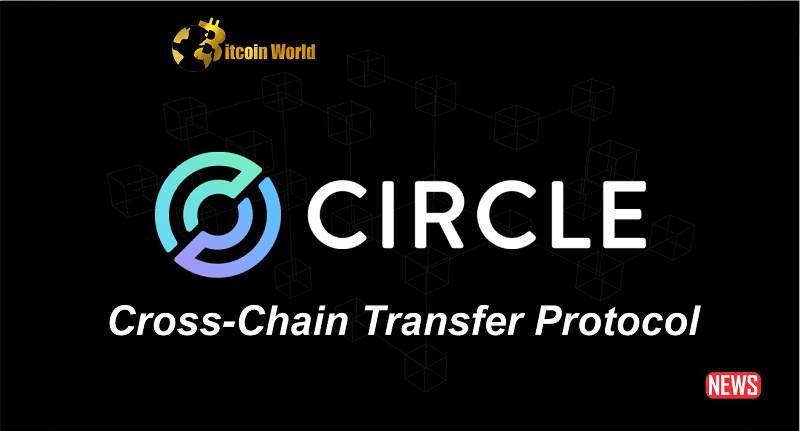Imagine a world where moving your digital dollars across different blockchains is as simple as sending an email. Well, that future is here! Circle, the issuer of the popular stablecoin USDC, just launched its highly anticipated Cross-Chain Transfer Protocol (CCTP) on the mainnet. This is a game-changer for the crypto space, promising seamless and permissionless transfers of USDC across a growing number of blockchain networks. Let’s dive into what this means for you.
What Exactly is Circle’s Cross-Chain Transfer Protocol (CCTP)?
Think of CCTP as a teleportation device for your USDC. As Circle explained in their blog post, the protocol allows USDC to be effectively “destroyed” on the originating blockchain and then instantly “recreated” on the destination chain at a 1:1 ratio. This isn’t just about moving numbers around; it’s about ensuring the value is securely transferred while maintaining the peg to the US dollar.
Why is CCTP a Big Deal?
Joao Reginatto, Circle’s VP of Product, emphasizes that CCTP is a “permissionless protocol designed for developers.” This means anyone can build applications that leverage this technology, opening up a world of possibilities. Here’s a breakdown of the key benefits:
- Seamless Transfers: Say goodbye to complex bridging solutions and the associated risks. CCTP offers a native and efficient way to move USDC.
- Developer Empowerment: Developers can now create applications that support multiple native versions of USDC, simplifying integration and expanding reach.
- Enhanced Interoperability: CCTP fosters greater interaction between different blockchain ecosystems, contributing to a more connected and efficient crypto landscape.
- Maintained Peg: Circle assures that its US dollar reserves remain intact throughout the transfer process, ensuring the stability of USDC.
Which Blockchains are Currently Supported?
As of the launch, USDC via CCTP is available on eight prominent blockchain networks:
- Ethereum
- Solana
- Avalanche
- TRON
- Algorand
- Stellar
- Flow
- Hedera
This broad initial support demonstrates Circle’s commitment to widespread adoption and accessibility.
Who is Already Integrating CCTP?
The excitement around CCTP is evident in the number of crypto infrastructure providers that have already integrated the protocol. This early adoption signifies the industry’s recognition of CCTP’s potential. Some of the key integrators include:
- Celer
- Hyperlane
- LayerZero
- LI.FI
- MetaMask
- Multichain
- Rarimo
- Router
- Socket
- Wanchain
- Wormhole
What Does This Mean for the Future of Money?
Circle envisions CCTP as a crucial step towards building an “open dollar developer platform” – a foundational layer for moving money on the internet. Reginatto aptly calls CCTP “the most ambitious piece of neutral market infrastructure that Circle has built since introducing USDC in 2018.” This highlights the significance of this launch for Circle and the broader crypto ecosystem.
USDC in the Current Market Landscape: A Quick Look
While USDC remains the second-largest stablecoin after Tether (USDT), it’s worth noting some recent market trends:
- Supply Dynamics: Unlike USDT, which has seen an increase in supply, USDC’s circulating supply has been decreasing.
- Market Share: USDC currently holds a 23.5% market share compared to Tether’s 62%. Circle estimates the current USDC supply to be around $31 billion, down 30% since the start of the year and 45% from its all-time high.
These figures provide context to the competitive stablecoin landscape and the ongoing evolution of the market.
The Bigger Picture: De-dollarization and the Need for Stablecoin Regulation
Circle’s CEO, Jeremy Allaire, has raised concerns about the growing trend of de-dollarization, particularly in Asia and Latin America. He emphasized the “very active de-dollarization taking place” and cited risks within the US banking system and government as contributing factors. Allaire urged the US government to accelerate stablecoin regulation and consider issuing a digital dollar CBDC, warning that failure to do so would be a “giant missed opportunity” for the country.
In Conclusion: CCTP – A Leap Towards a More Interconnected Crypto World
Circle’s launch of the Cross-Chain Transfer Protocol is a significant milestone in the journey towards a more interconnected and efficient blockchain ecosystem. By enabling seamless and permissionless USDC transfers, CCTP empowers developers, simplifies user experiences, and strengthens the utility of stablecoins. While the stablecoin landscape continues to evolve, CCTP positions USDC as a key player in the future of digital finance, paving the way for a more open and accessible financial system. Keep an eye on this space – the implications of CCTP are just beginning to unfold.
Disclaimer: The information provided is not trading advice, Bitcoinworld.co.in holds no liability for any investments made based on the information provided on this page. We strongly recommend independent research and/or consultation with a qualified professional before making any investment decisions.


